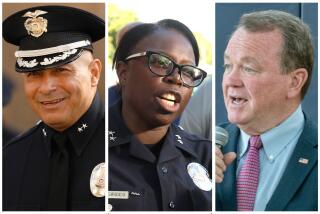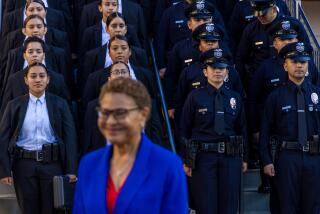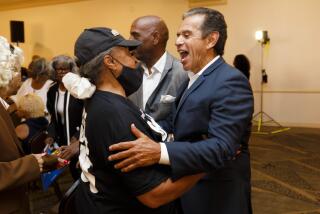Villaraigosa’s Big Team
Mayor-elect Antonio Villaraigosa’s transition team, which numbers more than 80 people, could devolve into a tower of Babel. Or, more optimistically, it could allow Villaraigosa to enter office with his mayoral arms around every interest he’ll need to call on later.
There’s no guidebook for political transitions. Many are chaotic and all are inevitably infused with some hard feelings between the ingoing and outgoing, between the chosen and unchosen in a new administration. What matters is whether an effective, knowledgeable staff emerges, as well as city boards and commissions that advise the mayor rather than funnel campaign cash.
The three most recent transitions in Los Angeles City Hall offer portraits of how varied the government-building process can be.
* Mayor James K. Hahn knew by the time he left the voting booth in 2001 that his chief of staff would be Tim McOsker, who had been his deputy in the city attorney’s office. He could leave it to McOsker to pick the rest of the mayoral staff. His chief political operative, Bill Wardlaw, focused on city boards and commissions, notably for the airports and port. Campaign manager Matt Middlebrook became director of communications. There was so little fuss that the news media hardly got a story out of it.
How did it turn out? On the weak side. There were no big, independently known names. And when Middlebrook left, he was succeeded by a former flack for the PR firm Fleishman-Hillard, now accused of overbilling the city while promoting the mayor. Hahn’s liaison to the airport and port commissions was a mid-level political operator who quit suddenly as pay-to-play scandals arose. If Hahn was getting vigorous good advice from his staff, it didn’t show.
* Richard Riordan’s transition was also headed by Wardlaw, but it involved about 20 people, according to campaign advisor Bill Carrick, who also worked with Hahn. Even that number was hard to handle, he said: “Nobody comes to listen and everybody comes to talk.” But from that process emerged a strong staff, notably Deputy Mayor Robin Kramer, a public policy wizard with gumption to stand up to Riordan. She’s now top dog in the Villaraigosa transition.
How did it turn out? Good start, weaker finish. A lot of the most capable staffers, including Kramer, left early. Riordan had five chiefs of staff in five years. No doubt his volcanic temper and lack of interest in any aspect of government that didn’t personally intrigue him had much to do with it.
* Villaraigosa meant to cause a stir when he released a list of transition advisors that included celebrities (Magic Johnson), Hollywood moguls (Sherry Lansing) and even a primary opponent (Bob Hertzberg), as well as the usual collection of developers, bankers, union officials, homeowners’ advocates, community organizers and religious leaders. Many of those named could end up on the more powerful boards and commissions. The symbolism is positive, but we hope he doesn’t plan to call them all to meetings.
How will it turn out? Check back in a year or so. The one certainty, given this start, is that it won’t be dull.
More to Read
Sign up for Essential California
The most important California stories and recommendations in your inbox every morning.
You may occasionally receive promotional content from the Los Angeles Times.









